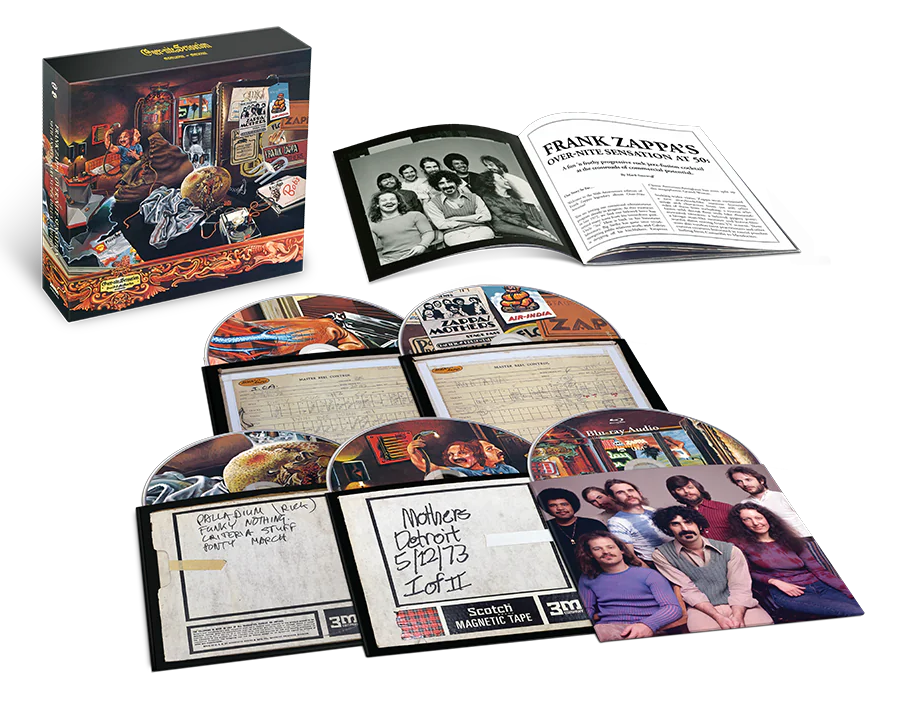Most immersive music fans would probably agree that Frank Zappa’s Waka/Wazoo box set ranked among the most impressive and unexpected reissues of 2022. In addition to four CDs’ worth of previously-unheard archival material, the set contained an audio-only Blu-Ray disc featuring amazing new 5.1 surround & Dolby Atmos mixes of Zappa’s 1972 albums Waka/Jawaka and The Grand Wazoo.
Nearly one year later, The Zappa Family Trust and Universal Music Group have joined forces once more to bring fans a similarly-packed 50th anniversary release of 1973’s Over-Nite Sensation. The album is notable for the uncredited appearance of Tina Turner & The Ikettes on backing vocals during several songs, including fan-favorite “Montana.” It was also Frank Zappa's first release to receive a gold certification from the RIAA.
In terms of immersive content, the set not only includes new 5.1 & Dolby Atmos mixes–again created by Karma Auger and Erich Gobel at Studio 1LA–but also a high-resolution digital transfer of Frank Zappa’s original four-channel quadraphonic mix from the ½-inch master tape. The Dolby Atmos mix is also available to stream on Apple Music, Tidal, and Amazon Music.

It’s clear that the new advent of quadraphonic sound was at the forefront of Zappa’s mind during the making of this record, as it’s referenced in the lyrics of the first track “Camarillo Brillo” (“she said her stereo was four-way…”). He was so enamored with the technology that in early 1973, he launched a new label called ‘DiscReet Records’ with then-business partner Herb Cohen centered around the immersive format.
All DiscReet releases were intended to be concurrently available on both traditional stereo and quadraphonic LP, though the label would ultimately issue only two quad albums: Over-Nite Sensation and its 1974 follow-up Apostrophe ('). However, Zappa Family Trust ‘Vaultmeister’ Joe Travers has confirmed that Frank also completed a four-channel mix of 1974’s double live album Roxy & Elsewhere.
Whereas most labels that issued quadraphonic product on vinyl utilized a ‘matrix’ process–which yielded imperfect separation between the front and rear channels–Warner Brothers (who distributed Frank Zappa’s music at this time) had instead adopted the far more sophisticated ‘CD-4’ (Compatible Discrete-4) system from which the DiscReet label partially owes its name.

Originally developed by JVC in Japan, the CD-4 process entailed hiding the rear channel audio information in a super high-frequency band beyond the range of human hearing. To properly play back a CD-4 LP (often called ‘Quadradiscs’ by the labels), one would have to purchase a special phono cartridge capable of retrieving these very high frequencies as well as an external preamp/decoding device called the ‘disc demodulator’ (pictured above).
Though CD-4 was certainly capable of performance rivaling any of the matrix systems (including CBS’ ‘SQ’ and Sansui’s ‘QS’ processes), the format was plagued by a multitude of issues including an arduous user calibration process, temperamental bouts of distortion, and high frequency roll-off. In the United States, Warner Brothers and RCA would both cease production of Quadradiscs by the end of 1975.
Though one might expect a four-corner extravaganza in the vein of Ten Years After’s A Space In Time or Black Sabbath’s Paranoid from the quad mix of Over-Nite Sensation, I’ve owned a copy of the Quadradisc for years (My Dad bought it new at an ‘Alexander’s’ department store in New York City during the mid-70s) and was never all that impressed with it.

There are definitely some moments of pronounced channel separation (such as the guitar at the beginning of “Camarillo Brillo” coming entirely from behind, or the swirling effects throughout “Fifty-Fifty”), but other elements such as the lead vocal and drum kit seem to emanate from all four corners at near-equal level.
Sonically, the quadraphonic mix as heard on the new Blu-Ray disc is a massive upgrade from the original vinyl and tape releases. Though I would still characterize it as a conservative surround sound presentation, it’s fascinating to hear exactly what Zappa heard in the studio all those decades ago and better appreciate the subtleties of his mixing decisions. While much of the instrumentation is indeed doubled in the front and rear channels for a 'big stereo' effect, there are also some unique elements mixed entirely to the back such as the chimes at the beginning of "Montana."
‘70s quad mixes often deviated quite far from the overall sound and feel of their stereo counterparts, but–no doubt due to the involvement of original engineer Kerry McNabb and Frank Zappa himself–the quad Over-Nite Sensation is remarkably faithful to the stereo mix. I’m not sure if Auger and Gobels referenced the quad version while remixing the album from the original multi-track tapes, but they seem to have taken Zappa’s original surround concept for the album and quite literally expanded it to new heights.
For some [Over-Nite Sensation was] a gateway to Zappa, a place to start along with the following 1974 release Apostrophe(’). It was also the first album by Zappa to be released in Quadraphonic surround sound. Quad was brand new to the consumer in 1973. It didn’t last long, but Zappa embraced the experience, ultimately mixing three of his records in the format before it went defunct in the marketplace (a similar fate to most surround formats in the coming years).
'Vaultmeister' Joe Travers, 2023
The new Dolby Atmos mix is truly an assault on the senses, with all 11 speakers in a 7.1.4 system getting their due. Frank Zappa’s lead vocal in songs like “Camarillo Brillo” and “Montana” remains to some degree 'omnipresent' (appearing simultaneously in the center channel, front heights, and rears at near-equal level), yet other elements such as keyboards, horns, backing vocals, percussion, and even guitar solos appear completely behind or above the listener.
For me, the most exciting aspect of this Atmos mix would have to be the treatment of Ralph Humphrey’s drum kit. The drums sound absolutely massive, with the big fills wildly roving all around the room. There's even a fair bit of drum sound in the height speakers! The usage of the center channel is interesting as well–it seems reserved primarily for Tom Fowler’s bass guitar work.
Horns blast out of the front heights for “I’m The Slime,” while keys burst from the sides and Zappa’s creepy vocals seem to come from inside your head. Backing vocals from Tina Turner & The Ikettes (“I am the slime from the radio…”) start in the rear speakers, then switch to the front. An extended double-tracked guitar solo in the side speakers takes us into the fade.

Multi-tracked vocals from both Zappa and The Ikettes are again spread all throughout the listening space for “Dirty Love,” with the guitar solo projecting directly into the center of the room. The crazy phased panning effects on Ricky Lancelotti’s vocals throughout “Fifty-Fifty” are certainly a highlight of the Atmos mix, as is Jean-Luc Ponty’s violin solo emanating entirety from the top speakers in that same tune.
More all-channel Zappa vocals kick off “Montana,” as keys percolate from the rear and horns pop up from above. The extended guitar solo at around the two-minute mark appears directly behind the listener’s head, while the crazy high-pitched backing vocals from The Ikettes seem divided mostly between the side right and front left height speakers.
In the age of 'Super Deluxe' box sets, where listeners are often required to fork over more than three figures to hear a single album in 5.1 or Atmos, around $65 for three(!) unique surround interpretations of Over-Nite Sensation and a plethora of interesting bonus material on the four included CDs represents an above-average value. Not to mention that the Dolby Atmos mixes could just as easily have been kept exclusive to the streaming services, as so often happens nowadays.


